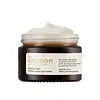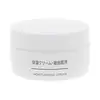What's inside
What's inside
 Key Ingredients
Key Ingredients

 Benefits
Benefits

 Concerns
Concerns

 Ingredients Side-by-side
Ingredients Side-by-side

Water
Skin ConditioningNiacinamide
SmoothingButyl Avocadate
Skin ConditioningButylene Glycol
HumectantSodium Acrylates Copolymer
Betaine
HumectantBenincasa Cerifera Fruit Extract
Skin ConditioningGlycerin
HumectantPropanediol
SolventMadecassic Acid
Skin ConditioningAsiatic Acid
Skin ConditioningAsiaticoside
AntioxidantCentella Asiatica Extract
CleansingPentylene Glycol
Skin ConditioningFerulic Acid
AntimicrobialPotassium Azeloyl Diglycinate
Skin ConditioningOleyl Erucate
EmollientCoco-Caprylate/Caprate
EmollientDicaprylyl Carbonate
EmollientEpilobium Angustifolium Flower/Leaf/Stem Extract
Skin ConditioningCaprylic/Capric Triglyceride
MaskingAloe Barbadensis Leaf Juice
Skin ConditioningBisabolol
MaskingGlycereth-26
HumectantLecithin
EmollientPhellodendron Amurense Bark Extract
Skin ConditioningAllantoin
Skin ConditioningEthylhexylglycerin
Skin ConditioningTocopherol
AntioxidantHydroxyacetophenone
AntioxidantTrisodium Ethylenediamine Disuccinate
Phenoxyethanol
PreservativeMelaleuca Alternifolia Leaf Oil
AntioxidantRosmarinus Officinalis Leaf Oil
MaskingWater, Niacinamide, Butyl Avocadate, Butylene Glycol, Sodium Acrylates Copolymer, Betaine, Benincasa Cerifera Fruit Extract, Glycerin, Propanediol, Madecassic Acid, Asiatic Acid, Asiaticoside, Centella Asiatica Extract, Pentylene Glycol, Ferulic Acid, Potassium Azeloyl Diglycinate, Oleyl Erucate, Coco-Caprylate/Caprate, Dicaprylyl Carbonate, Epilobium Angustifolium Flower/Leaf/Stem Extract, Caprylic/Capric Triglyceride, Aloe Barbadensis Leaf Juice, Bisabolol, Glycereth-26, Lecithin, Phellodendron Amurense Bark Extract, Allantoin, Ethylhexylglycerin, Tocopherol, Hydroxyacetophenone, Trisodium Ethylenediamine Disuccinate, Phenoxyethanol, Melaleuca Alternifolia Leaf Oil, Rosmarinus Officinalis Leaf Oil
Water
Skin ConditioningCyclopentasiloxane
EmollientEthylhexyl Palmitate
EmollientDipropylene Glycol
HumectantBehenyl Alcohol
EmollientBeeswax
Emulsion StabilisingGlycerin
HumectantOlea Europaea Fruit Oil
MaskingDimethicone
EmollientGlyceryl Stearate
EmollientPentylene Glycol
Skin ConditioningPentaerythrityl Tetraethylhexanoate
EmollientOctyldodecyl Myristate
EmollientPolysorbate 60
EmulsifyingPEG-75 Stearate
Simmondsia Chinensis Seed Oil
EmollientLimnanthes Alba Seed Oil
Skin ConditioningGlycosyl Trehalose
Emulsion StabilisingHydrogenated Starch Hydrolysate
HumectantAllantoin
Skin ConditioningPolyquaternium-51
Skin ConditioningSus Extract
Skin ConditioningSodium Hyaluronate
HumectantCitrus Grandis Seed Extract
AstringentButylene Glycol
HumectantTocopherol
AntioxidantPhenoxyethanol
PreservativeWater, Cyclopentasiloxane, Ethylhexyl Palmitate, Dipropylene Glycol, Behenyl Alcohol, Beeswax, Glycerin, Olea Europaea Fruit Oil, Dimethicone, Glyceryl Stearate, Pentylene Glycol, Pentaerythrityl Tetraethylhexanoate, Octyldodecyl Myristate, Polysorbate 60, PEG-75 Stearate, Simmondsia Chinensis Seed Oil, Limnanthes Alba Seed Oil, Glycosyl Trehalose, Hydrogenated Starch Hydrolysate, Allantoin, Polyquaternium-51, Sus Extract, Sodium Hyaluronate, Citrus Grandis Seed Extract, Butylene Glycol, Tocopherol, Phenoxyethanol
Ingredients Explained
These ingredients are found in both products.
Ingredients higher up in an ingredient list are typically present in a larger amount.
Allantoin is a soothing ingredient known for its protective and moisturizingg properties. Because of this, it is often added to products with strong active ingredients.
Studies show higher concentrations of this ingredient can promote wound healing.
Though it can be derived from the comfrey plant, allantoin is produced synthetically for cosmetic products to ensure purity.
Learn more about AllantoinButylene Glycol (or BG) is used within cosmetic products for a few different reasons:
Overall, Butylene Glycol is a safe and well-rounded ingredient that works well with other ingredients.
Though this ingredient works well with most skin types, some people with sensitive skin may experience a reaction such as allergic rashes, closed comedones, or itchiness.
Learn more about Butylene GlycolGlycerin is already naturally found in your skin. It helps moisturize and protect your skin.
A study from 2016 found glycerin to be more effective as a humectant than AHAs and hyaluronic acid.
As a humectant, it helps the skin stay hydrated by pulling moisture to your skin. The low molecular weight of glycerin allows it to pull moisture into the deeper layers of your skin.
Hydrated skin improves your skin barrier; Your skin barrier helps protect against irritants and bacteria.
Glycerin has also been found to have antimicrobial and antiviral properties. Due to these properties, glycerin is often used in wound and burn treatments.
In cosmetics, glycerin is usually derived from plants such as soybean or palm. However, it can also be sourced from animals, such as tallow or animal fat.
This ingredient is organic, colorless, odorless, and non-toxic.
Glycerin is the name for this ingredient in American English. British English uses Glycerol/Glycerine.
Learn more about GlycerinPentylene glycol is typically used within a product to thicken it. It also adds a smooth, soft, and moisturizing feel to the product. It is naturally found in plants such as sugar beets.
The hydrophilic trait of Pentylene Glycol makes it a humectant. As a humectant, Pentylene Glycol helps draw moisture from the air to your skin. This can help keep your skin hydrated.
This property also makes Pentylene Glycol a great texture enhancer. It can also help thicken or stabilize a product.
Pentylene Glycol also acts as a mild preservative and helps to keep a product microbe-free.
Some people may experience mild eye and skin irritation from Pentylene Glycol. We always recommend speaking with a professional about using this ingredient in your routine.
Pentylene Glycol has a low molecular weight and is part of the 1,2-glycol family.
Learn more about Pentylene GlycolPhenoxyethanol is a preservative that has germicide, antimicrobial, and aromatic properties. Studies show that phenoxyethanol can prevent microbial growth. By itself, it has a scent that is similar to that of a rose.
It's often used in formulations along with Caprylyl Glycol to preserve the shelf life of products.
Tocopherol (also known as Vitamin E) is a common antioxidant used to help protect the skin from free-radicals and strengthen the skin barrier. It's also fat soluble - this means our skin is great at absorbing it.
Vitamin E also helps keep your natural skin lipids healthy. Your lipid skin barrier naturally consists of lipids, ceramides, and fatty acids. Vitamin E offers extra protection for your skin’s lipid barrier, keeping your skin healthy and nourished.
Another benefit is a bit of UV protection. Vitamin E helps reduce the damage caused by UVB rays. (It should not replace your sunscreen). Combining it with Vitamin C can decrease sunburned cells and hyperpigmentation after UV exposure.
You might have noticed Vitamin E + C often paired together. This is because it is great at stabilizing Vitamin C. Using the two together helps increase the effectiveness of both ingredients.
There are often claims that Vitamin E can reduce/prevent scarring, but these claims haven't been confirmed by scientific research.
Learn more about TocopherolWater. It's the most common cosmetic ingredient of all. You'll usually see it at the top of ingredient lists, meaning that it makes up the largest part of the product.
So why is it so popular? Water most often acts as a solvent - this means that it helps dissolve other ingredients into the formulation.
You'll also recognize water as that liquid we all need to stay alive. If you see this, drink a glass of water. Stay hydrated!
Learn more about Water